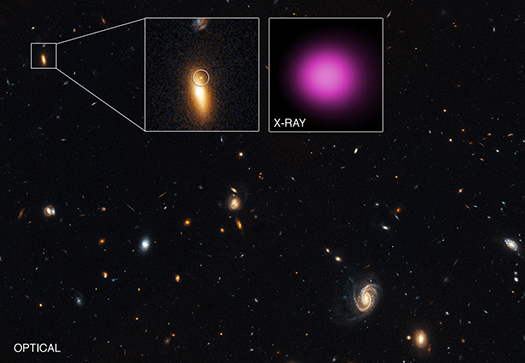X-ray Telescopes Find Evidence for Wandering Black Hole

Astronomers have used NASA's Chandra X-ray Observatory and ESA's XMM-Newton X-ray observatory to discover an extremely luminous, variable X-ray source located outside the center of its parent galaxy. This peculiar object could be a wandering black hole that came from a small galaxy falling into a larger one.
Astronomers think that supermassive black holes, with some 100,000 to 10 billion times the Sun's mass, are in the centers of most galaxies. There is also evidence for the existence of so-called intermediate mass black holes, which have lower masses ranging between about 100 and 100,000 times that of the Sun.
Both of these types of objects may be found away from the center of a galaxy following a collision and merger with another galaxy containing a massive black hole. As the stars, gas and dust from the second galaxy move through the first one, its black hole would move with it.
A new study reports the discovery of one of these "wandering" black holes toward the edge of the lenticular galaxy SDSS J141711.07+522540.8 (or, GJ1417+52 for short), which is located about 4.5 billion light years from Earth. This object, referred to as XJ1417+52, was discovered during long observations of a special region, the so-called Extended Groth Strip, with XMM-Newton and Chandra data obtained between 2000 and 2002. Its extreme brightness makes it likely that it is a black hole with a mass estimated to be about 100,000 times that of the Sun, assuming that the radiation force on surrounding matter equals the gravitational force.
The main panel of this graphic has a wide-field, optical light image from the Hubble Space Telescope. The black hole and its host galaxy are located within the box in the upper left. The inset on the left contains Hubble's close-up view of GJ1417+52. Within this inset the circle shows a point-like source on the northern outskirts of the galaxy that may be associated with XJ1417+52.
The inset on the right is Chandra's X-ray image of XJ1417+52 in purple, covering the same region as the Hubble close-up. This is a point source, with no evidence seen for extended X-ray emission.
The Chandra and XMM-Newton observations show the X-ray output of XJ1417+52 is so high that astronomers classify this object as a "hyper-luminous X-ray source" (HLX). These are objects that are 10,000 to 100,000 times more luminous in X-rays than stellar black holes, and 10 to 100 times more powerful than ultraluminous X-ray sources, or ULXs.
More information at http://chandra.si.edu/photo/2016/xj1417/index.html
-Megan Watzke, CXC
Category:
- Log in to post comments
